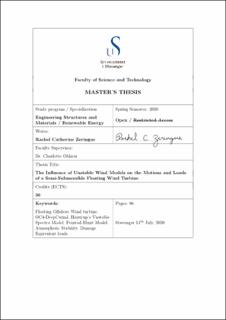| dc.contributor.advisor | Obhrai, Charlotte | |
| dc.contributor.author | Zeringue, Rachel | |
| dc.date.accessioned | 2021-02-16T10:22:37Z | |
| dc.date.available | 2021-02-16T10:22:37Z | |
| dc.date.issued | 2020-07-14 | |
| dc.identifier.uri | https://hdl.handle.net/11250/2728301 | |
| dc.description | Master's thesis in offshore structural engineering. | en_US |
| dc.description.abstract | As the wind turbine industry continues to play a part in the production of energy,
the need for larger and more powerful wind turbines keeps increasing. The movement
towards offshore wind turbine structures provides opportunities to increase power
production, but there are still adjustments that need to come to compensate with
the challenges of moving into deeper waters. Floating offshore wind turbines have
different structural and environmental factors when compared to onshore or even
bottom-fixed offshore wind turbines. The two recommended models for generating
wind profiles come from research on onshore wind turbines, with neutral atmospheric
stability. In deeper waters, it is much more harmful to ignore the effects of unstable
atmospheric stability conditions on the loading of a floating offshore wind turbine
(FOWT).
This master’s thesis will examine the influence of unstable atmospheric conditions
on a FOWT. The OC4-DeepCwind semi-submersible FOWT is the model that has
been chosen for this work. To generate the wind profiles, the Pointed-Blunt Model
and Højstrup’s Unstable Spectra Model will be used to examine the influence of
unstable wind on a FOWT. The turbulent wind fields are generated in MATLAB
before analysis in SIMA.
In general, it is noted that Højstup’s Unstable Spectra Model provides greater
turbulence intensity values, greater energy profiles, and greater damage equivalent
loads. As the atmospheric stability grows increasingly unstable, Højstrup’s Model
produces a notable change in the response of the FOWT. The Pointed-Blunt
Model has limited change from neutral to unstable to very unstable conditions and
generates smaller responses and loads. The tower base fore-aft moment produces
the greatest damage equivalent loads in both cases and is affected by both
increasing wind speed and the shift from neutral to more unstable conditions.
However, there can be improvements to the models and expanding of the
simulations that could contribute to a more extensive study. | en_US |
| dc.language.iso | eng | en_US |
| dc.publisher | University of Stavanger, Norway | en_US |
| dc.relation.ispartofseries | Masteroppgave/UIS-TN-IMBM/2020; | |
| dc.subject | konstruksjonsteknikk | en_US |
| dc.subject | offshore teknologi | en_US |
| dc.subject | vindturbiner | en_US |
| dc.subject | fornybar energi | en_US |
| dc.title | The Influence of Unstable Wind Models on the Motions and Loads of a Semi-Submersible Floating Wind Turbine | en_US |
| dc.type | Master thesis | en_US |
| dc.subject.nsi | VDP::Teknologi: 500 | en_US |
